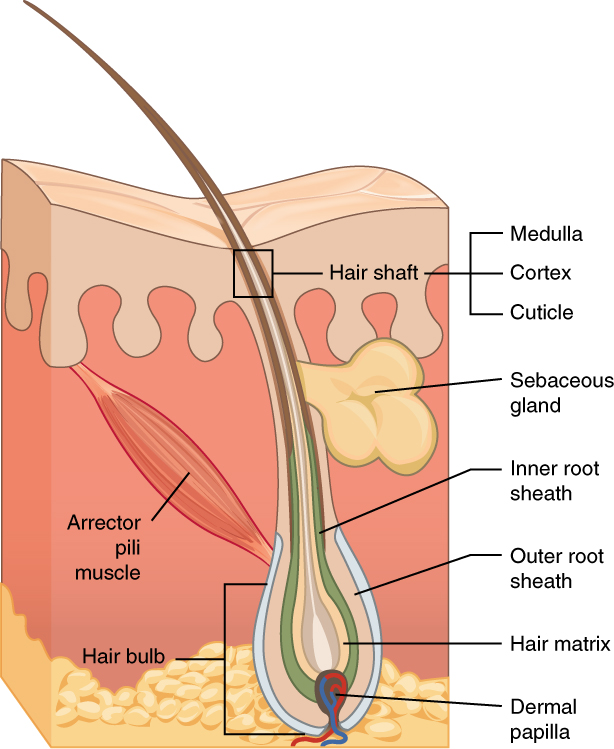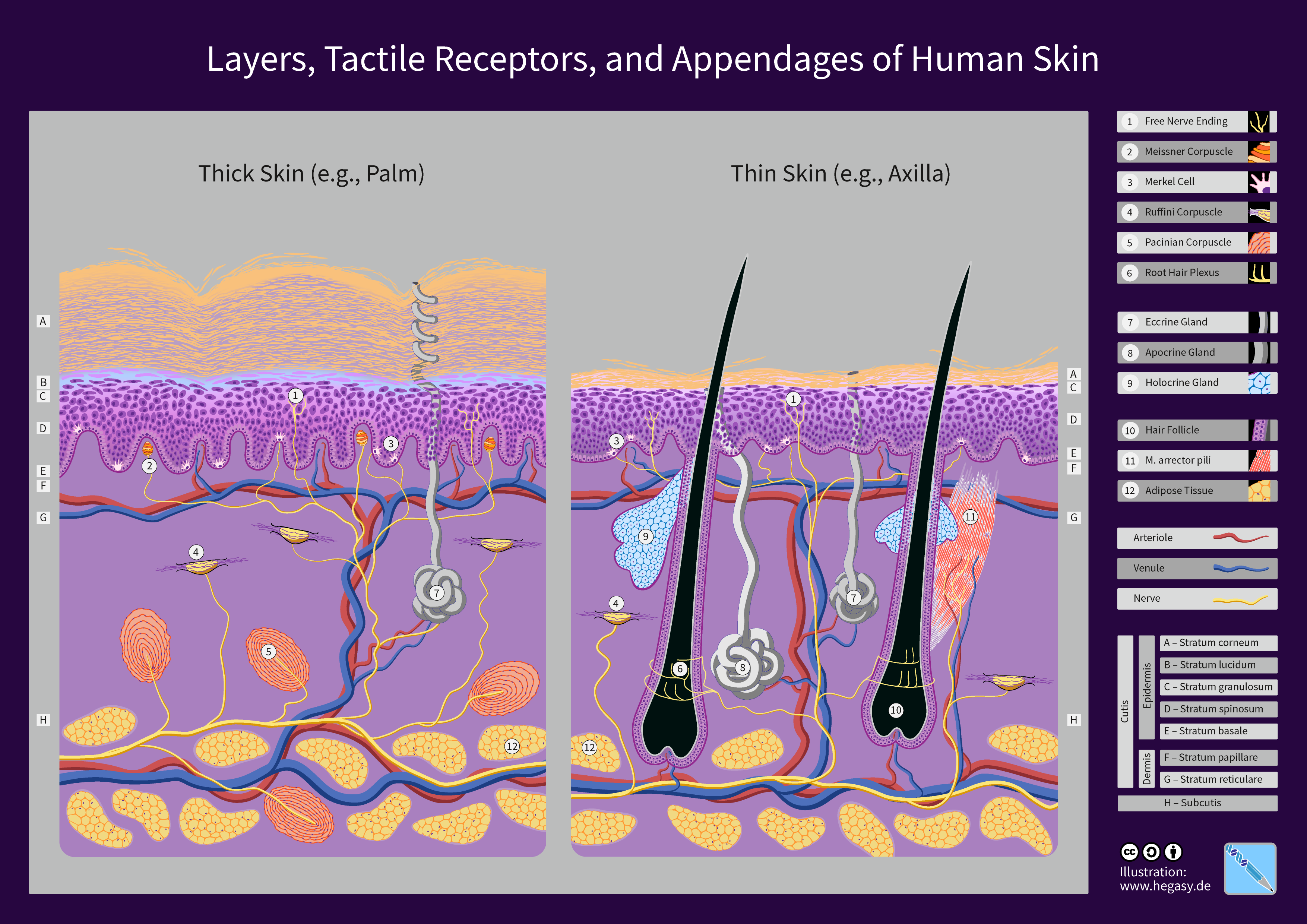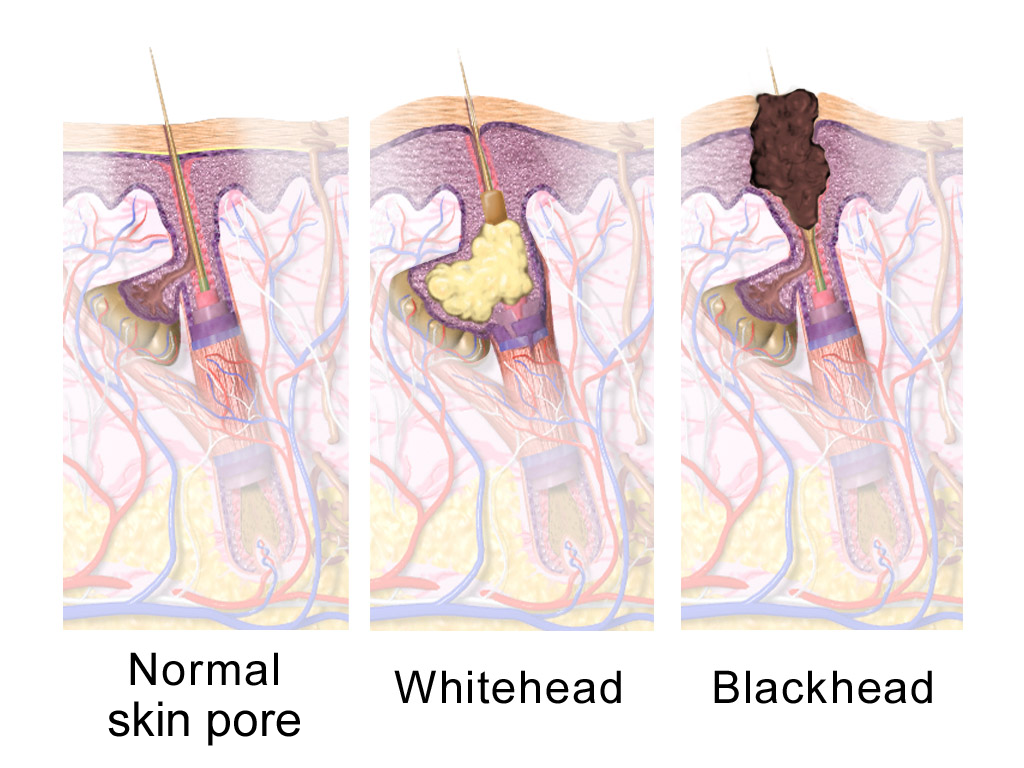|
Arrector Pili Muscle
The arrector pili muscles, also known as hair erector muscles, are small muscles attached to hair follicles in mammals. Contraction of these muscles causes the hairs to stand on end, known colloquially as goose bumps (piloerection). Structure Each arrector pili is composed of a bundle of smooth muscle fibres which attach to several follicles (a follicular unit). Each is innervated by the sympathetic division of the autonomic nervous system. The muscle attaches to the follicular stem cell niche in the follicular bulge, splitting at their deep end to encircle the follicle. Function The contraction of the muscle is involuntary. Stresses such as cold, fear etc. may stimulate the sympathetic nervous system, and thus cause muscle contraction. Thermal insulation Contraction of arrector pili muscles have a principal function in the majority of mammals of providing thermal insulation. Air becomes trapped between the erect hairs, helping the animal retain heat. Self defence Many ... [...More Info...] [...Related Items...] OR: [Wikipedia] [Google] [Baidu] |
Sympathetic Nervous System
The sympathetic nervous system (SNS or SANS, sympathetic autonomic nervous system, to differentiate it from the somatic nervous system) is one of the three divisions of the autonomic nervous system, the others being the parasympathetic nervous system and the enteric nervous system. The enteric nervous system is sometimes considered part of the autonomic nervous system, and sometimes considered an independent system. The autonomic nervous system functions to regulate the body's unconscious actions. The sympathetic nervous system's primary process is to stimulate the body's fight or flight response. It is, however, constantly active at a basic level to maintain homeostasis. The sympathetic nervous system is described as being antagonistic to the parasympathetic nervous system. The latter stimulates the body to "feed and breed" and to (then) "rest-and-digest". The SNS has a major role in various physiological processes such as blood glucose levels, body temperature, cardiac output, ... [...More Info...] [...Related Items...] OR: [Wikipedia] [Google] [Baidu] |
Hair Follicle
The hair follicle is an organ found in mammalian skin. It resides in the dermal layer of the skin and is made up of 20 different cell types, each with distinct functions. The hair follicle regulates hair growth via a complex interaction between hormones, neuropeptides, and immune cells. This complex interaction induces the hair follicle to produce different types of hair as seen on different parts of the body. For example, terminal hairs grow on the scalp and lanugo hairs are seen covering the bodies of fetuses in the uterus and in some newborn babies. The process of hair growth occurs in distinct sequential stages: ''anagen'' is the active growth phase, ''catagen'' is the regression of the hair follicle phase, ''telogen'' is the resting stage, ''exogen'' is the active shedding of hair phase and ''kenogen'' is the phase between the empty hair follicle and the growth of new hair. The function of hair in humans has long been a subject of interest and continues to be an impor ... [...More Info...] [...Related Items...] OR: [Wikipedia] [Google] [Baidu] |
Hair Anatomy
Hair is a protein filament that grows from follicles found in the dermis. Hair is one of the defining characteristics of mammals. The human body, apart from areas of glabrous skin, is covered in follicles which produce thick terminal and fine vellus hair. Most common interest in hair is focused on hair growth, hair types, and hair care, but hair is also an important biomaterial primarily composed of protein, notably alpha-keratin. Attitudes towards different forms of hair, such as hairstyles and hair removal, vary widely across different cultures and historical periods, but it is often used to indicate a person's personal beliefs or social position, such as their age, gender, or religion. Overview Meaning The word "hair" usually refers to two distinct structures: #the part beneath the skin, called the hair follicle, or, when pulled from the skin, the bulb or root. This organ is located in the dermis and maintains stem cells, which not only re-grow the hair after it falls o ... [...More Info...] [...Related Items...] OR: [Wikipedia] [Google] [Baidu] |
Skin Layers
The human skin is the outer covering of the body and is the largest organ of the integumentary system. The skin has up to seven layers of ectodermal tissue guarding muscles, bones, ligaments and internal organs. Human skin is similar to most of the other mammals' skin, and it is very similar to pig skin. Though nearly all human skin is covered with hair follicles, it can appear hairless. There are two general types of skin: hairy and glabrous skin (hairless). The adjective ''cutaneous'' literally means "of the skin" (from Latin ''cutis'', skin). Skin plays an important immunity role in protecting the body against pathogens and excessive water loss. Its other functions are insulation, temperature regulation, sensation, synthesis of vitamin D, and the protection of vitamin B folates. Severely damaged skin will try to heal by forming scar tissue. This is often discoloured and depigmented. In humans, skin pigmentation (affected by melanin) varies among populations, and ... [...More Info...] [...Related Items...] OR: [Wikipedia] [Google] [Baidu] |
Hair Shaft
Hair is a protein filament that grows from follicles found in the dermis. Hair is one of the defining characteristics of mammals. The human body, apart from areas of glabrous skin, is covered in follicles which produce thick terminal and fine vellus hair. Most common interest in hair is focused on hair growth, hair types, and hair care, but hair is also an important biomaterial primarily composed of protein, notably alpha-keratin. Attitudes towards different forms of hair, such as hairstyles and hair removal, vary widely across different cultures and historical periods, but it is often used to indicate a person's personal beliefs or social position, such as their age, gender, or religion. Overview Meaning The word "hair" usually refers to two distinct structures: #the part beneath the skin, called the hair follicle, or, when pulled from the skin, the bulb or root. This organ is located in the dermis and maintains stem cells, which not only re-grow the hair after it falls o ... [...More Info...] [...Related Items...] OR: [Wikipedia] [Google] [Baidu] |
Sebaceous Glands
A sebaceous gland or oil gland is a microscopic exocrine gland in the skin that opens into a hair follicle to secrete an oily or waxy matter, called sebum, which lubricates the hair and skin of mammals. In humans, sebaceous glands occur in the greatest number on the face and scalp, but also on all parts of the skin except the palms of the hands and soles of the feet. In the eyelids, meibomian glands, also called tarsal glands, are a type of sebaceous gland that secrete a special type of sebum into tears. Surrounding the female nipples, areolar glands are specialized sebaceous glands for lubricating the nipples. Fordyce spots are benign, visible, sebaceous glands found usually on the lips, gums and inner cheeks, and genitals. Structure Location In humans, sebaceous glands are found throughout all areas of the skin, except the palms of the hands and soles of the feet. There are two types of sebaceous glands: those connected to hair follicles and those that exist indepen ... [...More Info...] [...Related Items...] OR: [Wikipedia] [Google] [Baidu] |
Traction Alopecia
Traction alopecia is a type of alopecia or hair loss caused by a chronic pulling force being applied to the hair. It commonly results from a person frequently wearing their hair in a particularly tight ponytail, pigtails, or braids with increased likelihood when hair is chemically relaxed as this compromises the hair shaft's tensile strength resulting in hair breakage. Traction alopecia causes a recession of the hairline due to chronic traction, which is characterized by a fringe along the marginal hairline on physical exam. Diagnosis is clinical and treatment directed at cessation of the chronic traction, while cosmeses, with surgical restoration is reserved for severe cases with scarring fibrosis. Cause Traumatic hairstyle It is commonly seen with certain hair styles like a particularly tight ponytail, pigtails, braid or braiding pattern that pulls the hairline forcefully towards the vertex of the scalp, and has been reported more often in African American women (as some w ... [...More Info...] [...Related Items...] OR: [Wikipedia] [Google] [Baidu] |
Alpha-1 Adrenergic Receptor
alpha-1 (α1) adrenergic are G protein-coupled receptors (GPCRs) associated with the Gq alpha subunit, Gq heterotrimeric G protein. α1-adrenergic receptors are subdivided into three highly homologous subtypes, i.e., α1A-adrenergic, α1A-, α1B-adrenergic, α1B-, and α1D-adrenergic, α1D-adrenergic receptor subtypes. There is no α1C receptor. At one time, there was a subtype known as α1C, but it was found to be identical to the previously discovered α1A receptor subtype. To avoid confusion, naming was continued with the letter D. Catecholamines like norepinephrine (noradrenaline) and epinephrine (adrenaline) signal through the α1-adrenergic receptors in the central nervous system, central and peripheral nervous systems. The crystal structure of the α1B-adrenergic receptor subtype has been determined in complex with the inverse agonist (+)-cyclazosin. Effects The α1-adrenergic receptor has several general functions in common with the Alpha-2 adrenergic receptor, α2-adrene ... [...More Info...] [...Related Items...] OR: [Wikipedia] [Google] [Baidu] |
Leprosy
Leprosy, also known as Hansen's disease (HD), is a Chronic condition, long-term infection by the bacteria ''Mycobacterium leprae'' or ''Mycobacterium lepromatosis''. Infection can lead to damage of the Peripheral nervous system, nerves, respiratory tract, skin, and eyes. This nerve damage may result in a lack of ability to feel pain, which can lead to the loss of parts of a person's Appendicular skeleton, extremities from repeated injuries or infection through unnoticed wounds. An infected person may also experience muscle weakness and poor eyesight. Leprosy symptoms may begin within one year, but for some people symptoms may take 20 years or more to occur. Leprosy is spread between people, although extensive contact is necessary. Leprosy has a low pathogenicity, and 95% of people who contract or who are exposed to ''M. leprae'' do not develop the disease. Spread is likely through a cough or contact with fluid from the nose of a person infected by leprosy. Genetic factors and i ... [...More Info...] [...Related Items...] OR: [Wikipedia] [Google] [Baidu] |
Sebum
A sebaceous gland or oil gland is a microscopic exocrine gland in the skin that opens into a hair follicle to secrete an oily or waxy matter, called sebum, which lubricates the hair and skin of mammals. In humans, sebaceous glands occur in the greatest number on the face and scalp, but also on all parts of the skin except the palms of the hands and soles of the feet. In the eyelids, meibomian glands, also called tarsal glands, are a type of sebaceous gland that secrete a special type of sebum into tears. Surrounding the female nipples, areolar glands are specialized sebaceous glands for lubricating the nipples. Fordyce spots are benign, visible, sebaceous glands found usually on the lips, gums and inner cheeks, and genitals. Structure Location In humans, sebaceous glands are found throughout all areas of the skin, except the palms of the hands and soles of the feet. There are two types of sebaceous glands: those connected to hair follicles and those that ... [...More Info...] [...Related Items...] OR: [Wikipedia] [Google] [Baidu] |
Postganglionic Nerve Fibers
In the autonomic nervous system, nerve fibers from the ganglion to the effector organ are called postganglionic nerve fibers. Neurotransmitters The neurotransmitters of postganglionic fibers differ: * In the parasympathetic division, neurons are ''cholinergic''. That is to say acetylcholine is the primary neurotransmitter responsible for the communication between neurons on the parasympathetic pathway. * In the sympathetic division, neurons are mostly ''adrenergic'' (that is, epinephrine and norepinephrine function as the primary neurotransmitters). Notable exceptions to this rule include the sympathetic innervation of sweat glands and arrectores pilorum muscles where the neurotransmitter at both pre and post ganglionic synapses is acetylcholine. Another notable structure is the medulla of the adrenal gland, where chromaffin cells function as modified post-ganglionic nerves. Instead of releasing epinephrine and norepinephrine into a synaptic cleft, these cells of the adrenal ... [...More Info...] [...Related Items...] OR: [Wikipedia] [Google] [Baidu] |
Sympathetic Nervous System
The sympathetic nervous system (SNS or SANS, sympathetic autonomic nervous system, to differentiate it from the somatic nervous system) is one of the three divisions of the autonomic nervous system, the others being the parasympathetic nervous system and the enteric nervous system. The enteric nervous system is sometimes considered part of the autonomic nervous system, and sometimes considered an independent system. The autonomic nervous system functions to regulate the body's unconscious actions. The sympathetic nervous system's primary process is to stimulate the body's fight or flight response. It is, however, constantly active at a basic level to maintain homeostasis. The sympathetic nervous system is described as being antagonistic to the parasympathetic nervous system. The latter stimulates the body to "feed and breed" and to (then) "rest-and-digest". The SNS has a major role in various physiological processes such as blood glucose levels, body temperature, cardiac output, ... [...More Info...] [...Related Items...] OR: [Wikipedia] [Google] [Baidu] |






